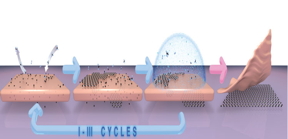Home > Press > Graphene crystals grow better under copper cover
 |
| A schematic illustration of the single-crystal graphene sheets grown on an insulating substrate. The method could enhance next-generation nanomaterial-based devices.
© Springer Nature; Reproduced with permission from Junzhu Li et al (2022). |
Abstract:
An approach that produces single-crystal graphene sheets on large-scale electrically insulating supports could help with the development of next-generation nanomaterial-based devices, such as very light and thin touchscreens, wearable electronics and solar cells.
Graphene crystals grow better under copper cover
Thuwal, Saudi Arabia | Posted on April 1st, 2022
Most graphene-based electronic devices require insulating supports. Yet, high-quality graphene films destined for industrial use typically are grown on a metal substrate, such as copper foil, before being transferred to an insulating support for device fabrication. This transfer step can introduce impurities that affect how well the device performs. Efforts to grow graphene on insulating supports have not been able to produce the required high-quality single crystals.
If graphene can be grown on an insulating substrate with a clean interface, certain devices might function better, says Ph.D. student Bo Tian, who co-led the study under Xixiang Zhangs supervision. This also opens the door to new types of graphene-based nanodevices, he explains.
Zhang, Tian and coworkers from Asia and Europe tweaked the chemical vapor deposition method, which relies on the copper-catalyzed decomposition of methane into carbon precursors, to generate smooth single-crystal graphene monolayers on wafer-scale single-crystal substrates called c-plane sapphire.
The researchers converted polycrystalline copper foil into its single-crystal counterpart Cu(111) on the sapphire surface and introduced active carbon atoms from the metal substrate-catalyzed decomposition of methane on the resulting film. The carbon atoms diffused through the metallic film toward the coppersapphire interface, which acted as a template, and formed well-oriented graphene islands that, after several growth cycles, merged to yield a sheet.
In addition to weak surface interactions, the copper film and sapphire displayed similar crystal lattice symmetry to that of graphene, Tian says, which explains the high crystallinity of the graphene monolayer.
The researchers etched away any graphene that had accumulated on top of the copper film using a hydrogenargon plasma to facilitate carbon diffusion. They immersed the samples in liquid nitrogen before heating them rapidly to 500 degrees Celsius, making the copper film easy to peel off while keeping the graphene monolayer intact.
Field-effect transistors manufactured on the sapphire-grown single-crystal graphene monolayer exhibited excellent performance with higher carrier mobilities. The superior electronic performance of the graphene grown on sapphire results from its higher crystallinity and fewer folds on the surface, Tian explains.
Our team is now trying to grow other two-dimensional materials on the insulator-supported graphene to build functionalized large-scale heterostructures, Tian says. These heterostructures held together by van der Waals interactions are expected to be useful in future nanodevices.
####
For more information, please click here
Contacts:
Michael Cusack
King Abdullah University of Science & Technology (KAUST)
Office: 009660128083040
Expert Contact
Xixiang Zhang
King Abdullah University of Science and Technology (KAUST)
Copyright © King Abdullah University of Science & Technology (KAUST)
If you have a comment, please Contact us.
Issuers of news releases, not 7th Wave, Inc. or Nanotechnology Now, are solely responsible for the accuracy of the content.
News and information
![]()
Nano therapy for micro-preemies protects lungs, brain in lab study April 1st, 2022
![]()
Scavenger nanoparticles could make fuel cell-powered vehicles a reality April 1st, 2022
Graphene/ Graphite
![]()
Graphene gets enhanced by flashing: Rice process customizes one-, two- or three-element doping for applications March 31st, 2022
![]()
Protective equipment with graphene nanotubes meets the strictest ESD safety standards March 25th, 2022
2 Dimensional Materials
![]()
Graphene gets enhanced by flashing: Rice process customizes one-, two- or three-element doping for applications March 31st, 2022
![]()
Revealing new states in 2D materials February 25th, 2022
![]()
2D materials could be used to simulate brain synapses in computers January 28th, 2022
Display technology/LEDs/SS Lighting/OLEDs
![]()
Inorganic borophene liquid crystals: A superior new material for optoelectronic devices February 25th, 2022
![]()
Organic light emitting diodes operated by 1.5 V battery January 7th, 2022
Wearable electronics
![]()
New brain-like computing device simulates human learning: Researchers conditioned device to learn by association, like Pavlov’s dog April 30th, 2021
Possible Futures
![]()
Nano therapy for micro-preemies protects lungs, brain in lab study April 1st, 2022
![]()
Scavenger nanoparticles could make fuel cell-powered vehicles a reality April 1st, 2022
![]()
Self-standing mesoporous Si film can power lithium-ion batteries Peer-Reviewed Publication April 1st, 2022
Discoveries
![]()
Nano therapy for micro-preemies protects lungs, brain in lab study April 1st, 2022
![]()
Self-standing mesoporous Si film can power lithium-ion batteries Peer-Reviewed Publication April 1st, 2022
![]()
Quantum shock absorbers allow perovskite to exhibit superfluorescence at room temperature April 1st, 2022
Announcements
![]()
Self-standing mesoporous Si film can power lithium-ion batteries Peer-Reviewed Publication April 1st, 2022
![]()
Quantum shock absorbers allow perovskite to exhibit superfluorescence at room temperature April 1st, 2022
![]()
Could quantum technology be New Mexicos next economic boon? Quantum New Mexico Coalition aims to establish state as national hub April 1st, 2022
Interviews/Book Reviews/Essays/Reports/Podcasts/Journals/White papers/Posters
![]()
Nano therapy for micro-preemies protects lungs, brain in lab study April 1st, 2022
![]()
Scavenger nanoparticles could make fuel cell-powered vehicles a reality April 1st, 2022
![]()
Self-standing mesoporous Si film can power lithium-ion batteries Peer-Reviewed Publication April 1st, 2022
![]()
Quantum shock absorbers allow perovskite to exhibit superfluorescence at room temperature April 1st, 2022
Solar/Photovoltaic
![]()
Peering into precise ultrafast dynamics in matter March 25th, 2022
![]()
Workhorse of photovoltaics combined with perovskite in tandem for the first time February 25th, 2022
![]()
Scientists enhance energy storage capacity of graphene supercapacitors via solar heating January 28th, 2022










